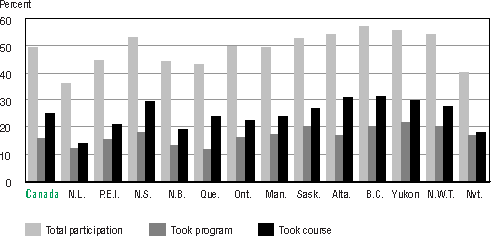
A lifelong learning culture implies continuous learning throughout the working life and the years beyond. Such involvement in learning is likely to help maintain competencies and to help acquire additional knowledge and skills. The 2003 IALSS collected data on participation in various forms of adult education and learning during the twelve months preceding the interview.
In Canada, almost 50 percent of the population aged 16 to 65 participates in some form of adult education and learning activities. The IALSS differentiated between participation in programs of study, defined as a collection of courses that leads to a credential, and participation in organized courses that were not part of a program. The proportion enrolling in organized courses is higher than the proportion participating in programs of study - 25 percent compared to 16 percent. For the most part, participation rates in the jurisdictions are close to the national rate. The rate is significantly below the national average in Newfoundland and Labrador, Quebec and Nunavut and above the national average in British Columbia (Figure 4.8).
Figure 4.8
Source: International Adult Literacy and Skills Survey, 2003.
Proficiency in literacy, numeracy and problem solving provides the foundation for the acquisition of new knowledge and skills. Across all regions, those who participate in adult learning activities have higher average scores in all domains (Figure 4.9).
In all regions, as proficiency levels increase, so too does participation in adult learning. In all provinces and territories there is a substantial difference between the participation rates of those with the lowest and highest levels of literacy. Participation rates among those with Level 1 proficiency in document literacy are at about 20 percent compared to about 70 percent among those at Level 4/5 (Figure 4.10).